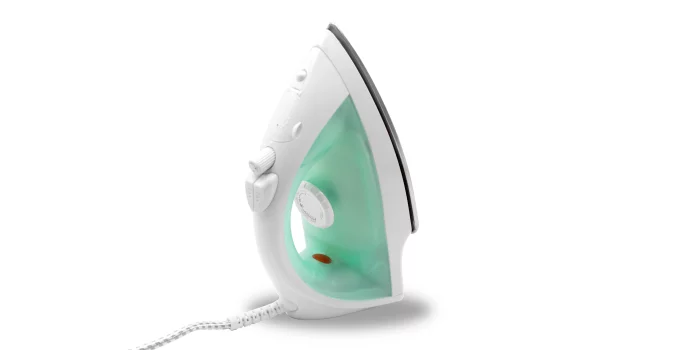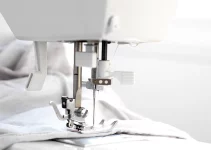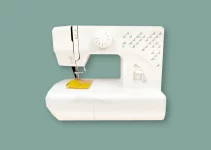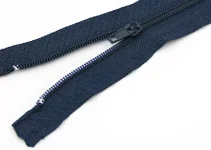Answering the question what is a cool iron actually leads us to delving shortly into a guide on how to iron clothes.
Basically, a cool iron means ironing certain fabrics and clothes at a low or medium temperature setting.
Thus, a cool iron refers to selecting a low temperature or the two lowest settings for these appliances.
Simply put, we are instructed to use a cool iron, meaning at a low temperature and not the highest it can achieve, when we’re dealing with synthetics, delicates, wool, lingerie, silk.
Of course, the iron’ soleplate will still put off heat so don’t put your fingers on it under any circumstances. The temperature is just at least half lower than it would be on the highest setting.
Which setting we should use for ironing is indicated on the tags of our clothes.
An icon of an iron with one dot means that we should use the lowest setting.
If the iron icon contains two dots, that means the medium setting.
And three dots is the high temperature setting.
We might also have clothes with a do not iron icon. Or a do not use steam icon.
Also, check out my recommendation for the best spray starch for ironing if you are interested in discovering some amazing products.
What is A Cool Iron? How Do We Use It?
Let’s take this user manual for a Hamilton Beach iron. I like this user manual because it includes a helpful table.
Each iron will come with a temperature settings button.
For the Hamilton Beach that I have chosen as an example, the settings are:
- Synthetics – one dot
- Wool – two dots
- Silk – three dots
- Cotton, linen
Thus, the temperature is not 1, 2, 3. Pretty much all models will indicate their temperature setting in this manner.
If you want another example, you can check out this user manual for a Rowenta.
They also have a table with the following instructions for setting the temperature:
- the lowest temperature is for synthetic fibers, viscose, polyester
- second for silk and wool
- and highest temperature is for cotton, linen
Thus, a cool iron is when we set up the temperature on either level 1 or level 2.
As you saw, level 1 is for synthetics, like polyester and viscose rayon. This is the lowest temperature. I would say that it’s also good for some fabric blends and delicates.
The medium temperature is level 2 for wool and silk.
These two first temperature levels are the answer to our very important question: what is a cool iron?
There are also irons that come with more than those 3 settings.
Black+Decker has models like those. On those, the settings are:
- synthetic
- nylon silk
- polyester rayon
- blend
- wool
- cotton, linen
Overall, there are more of them but they pretty much cover the same type of fabrics or blends.
When should we use cold ironing?
Also, keep in mind that the name is a bit misleading because the soleplate still gets quite hot so don’t touch it with bare fingers.
Otherwise, if the soleplate was completely cold, there would be no ironing done. You might as well just take your bare hands and try to remove those wrinkles and creases without any heat involved. That’s not possible.
Just like we do with washing, we must also check out the tags on our clothes to see what the instructions are for ironing. It’s just as important as the temperature we set on our washing machine if we want our clothes to maintain their fabrics undamaged.
Of course, synthetics require a cool iron because these types of fabrics or fabric blends don’t do well with high heat because their fibers can be damaged or even melted a bit.
Thus, if the tag on your clothes says cool iron, I recommend starting with the lowest setting, the one called synthetics, if you don’t know the fabric or fabric blend that you’re dealing with, although that is also information written on the tags.
If you’re ironing wool or silk, then you already have a setting that indicates these two fabrics. It’s the medium heat one, or temperature setting no. 2.
The highest temperature is reserved for cotton, linen.
How to Iron Clothes
There are two important things we must do: we must read the user manual that comes with our iron and we must check the tags on our clothes.
If there are no tags, we’re left to establish what type of fabric or blend we’re trying to remove the wrinkles and creases from.
As we’ve answered the question what is a cool iron, you saw that there are 3 main temperature settings on an iron.
And that we’re talking about cold ironing, using the two lowest settings, for synthetics, delicates, wool, lingerie, silk.
If we’re dealing with cotton, linen then we can use the max temperature, which is usually the third setting. It helps that irons actually have these fabrics written on them so there’s not much to figure out in this area.
Another thing we’ll see is that the steam setting for synthetics, silk, and wool is dry iron.
The wool setting could also be used if you’re ironing cashmere. However, as this article states some people will not recommend ironing cashmere clothing. Steaming cashmere is preferable as ironing can flatten the natural pile of the yarns and pull it out of shape.
Steam is used for cotton, linen. Denim is also ironed with this setting, the three dots one or the one where cotton linen is written.
Tips for the best ironing results
Let’s get over some important tips that we should know since they’re quite related to our question of what is a cool iron. I told you that this will turn into a mini how to iron clothes guide.
Check labels
Of course, that’s the first thing that most of us are going to do. And we’ve already covered the temperature settings on an iron.
If the fabric is a blend, use a low temperature setting.
If you don’t know what type of fabric you have, use the lowest temperature first. Always test on an inside seam.
Prepare to iron
Your ironing board should be covered with a padded, heat-resistant cover. Make sure that it’s completely clean, free of any dust or dirt that might end up on our clothes.
Have the ironing board to a height that is comfortable on your arms.
Make sure that the soleplate is completely clean.
If you want to clean your soleplate, run it at the highest temperature over a damp 100% cotton cloth.
And there are also iron with a self-clean function. But that only takes care of the steam holes, not the entire soleplate.
Preheat the iron
If we’re cold ironing, the appliance will reach the needed temperature more quickly than if we were using the highest temperature. There is generally a light that will bling while preheating.
Once preheating is done, we can get started.
Iron with a lengthwise motion. If you’re doing it in circular motions, it might stretch the fabric.
We won’t use steam on the first two settings but we will use it with natural fibers (cotton and linen).
All in all, understanding what is a cool iron actually depends on establishing the right temperature setting for our fabrics and, as we saw, the ones that belong in the cold ironing category are synthetics, delicates, wool, lingerie, silk.




